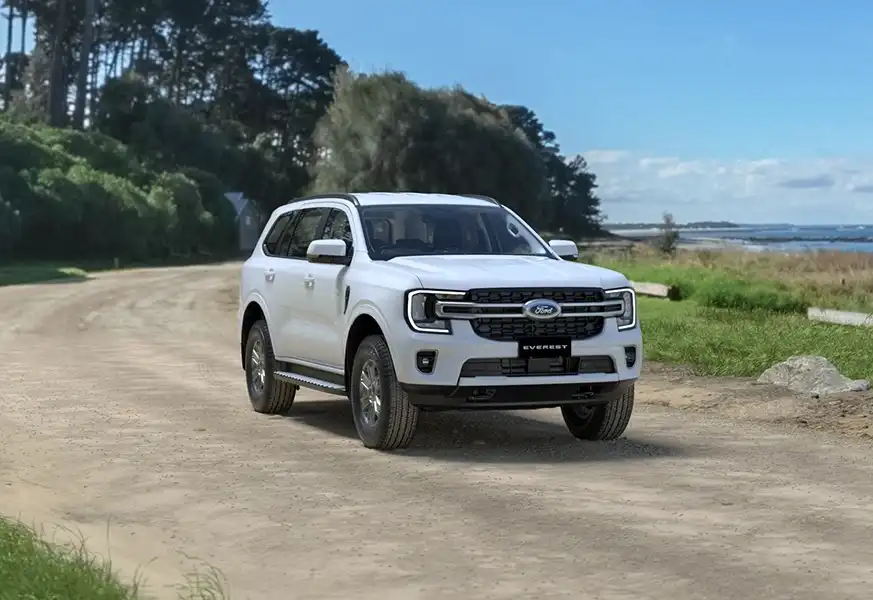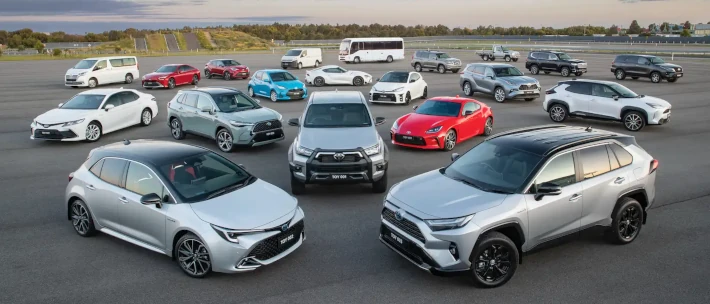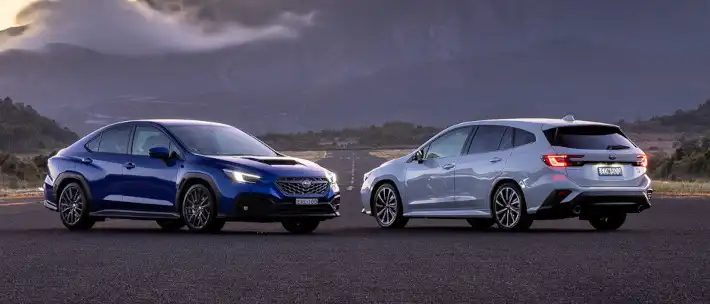With a large footprint, acres of interior space and a choice of two great engines with 4x4 systems on offer, there’s a lot to like about the Ford Everest’s versatile nature.
For 2025, the Ford Everest hits the market with just some minor equipment additions, namely at the pointy end of the range.
Is the Ford Everest still the benchmark in the adventurous large 4x4 SUV segment? Let’s take a closer look to find out.
Ford Everest Competition
Ford Everest |
VS |
Isuzu MU-X |
| Toyota Fortuner | ||
| Mitsubishi Pajero Sport | ||
| LDV D90 | ||
| SsangYong Rexton | ||
| Kia Sorento | ||
| Hyundai Santa Fe | ||
| GWM Tank 500 |
How Much Does the MY25.25 Ford Everest Cost?
Prices for the MY25.25 Ford Everest lineup kick off from $54,240 for the entry-level Everest Ambiente 4x2 bi-turbo, with prices rising to $59,240 for the Everest Ambiente 4x4 bi-turbo.
Stepping up to the Everest Sport 4x2 bi-turbo brings the price to $63,740 while the Everest Trend 4x4 bi-turbo is priced at $67,040 and the Everest Sport 4x4 V6 is priced at $74,640.
Finally, the Everest range is rounded out by the Everest Tremor 4x4 V6 which is priced at $76,590 and the range-topping Everest Platinum which wears a price tag of $81,200.
Keep in mind that these prices are subject to change and do not include on-road costs.
How Much Can OnlineAuto Save You?
Using OnlineAuto’s car buying service, you could save thousands on your next car with the help of our team of car-buying specialists.
Get in touch with one of our Car Buying Specialists today.
Request a quoteWhat Features & Specs Does the 2025 Ford Everest Have?
Ford’s entry-level Everest Ambiente range comes riding on a set of 17-inch alloys wrapped in all-season tyres and receives LED headlights with LED tail lights and daytime running lamps along with black side steps, steel underbody protection, adaptive cruise control, a rear-view camera with front & rear parking sensors, a five-seat layout with cloth upholstery, keyless entry & start, an 8.0-inch digital instrument cluster, a wireless charging pad, drive modes and a locking rear differential for 4x4 variants.
Stepping up to the Ford Everest Trend adds 18-inch alloys, a seven-seat layout, a powered boot lift, a 400-watt power inverter, leather upholstery with a power-adjustable driver’s seat, black roof rails, privacy glass, an upper glove box, off-road screen and added off-road drive modes for 4x4 versions.
Buyers opting for the Everest Sport pick up black 20-inch alloys with black exterior highlights, upgraded leather upholstery with a power-adjustable passenger’s seat and both heated and ventilated first-row seats.
The adventure-focussed Everest Tremor range receives a set of General Grabber AT3 tyres, upgraded Bilstein dampers, steel bash plate, upgraded side steps, a bespoke honeycomb grille with LED lamps, added drive modes and bolder grey wheel arches.
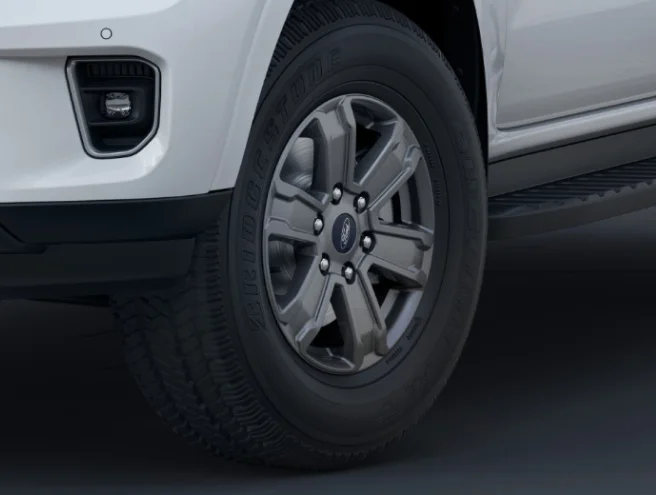
Image courtesy of ford.com.au
Finally, the range-topping Everest Platinum builds upon the Sport’s equipment list and adds 21-inch alloys, Matrix LED headlights, a black roof with chrome highlights, a 12.4-inch digital instrument cluster, a surround-view monitor, quilted leather upholstery with heated second-row seats and a heated steering wheel, ambient lighting, power-folding third-row seats and tyre pressure monitoring.
Ford Everest Connectivity & Infotainment Features
The Ford Everest remains one of the most competitive options in the large SUV segment when it comes to technology.
In base form, buyers receive Ford’s 10.1-inch Sync4 infotainment system mounted vertically which looks great thanks to its crisp, high-definition display.
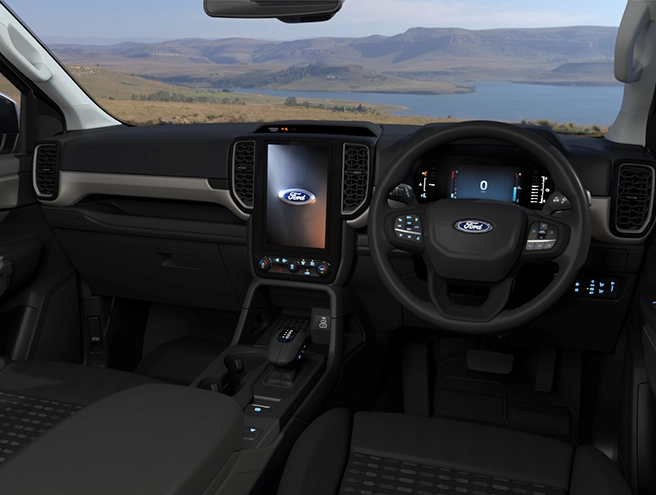
Image courtesy of ford.com.au
Ford’s 10.1-inch infotainment display is packaged with AM/FM radio, DAB+ digital radio, satellite navigation, a voice assistant, a built-in modem and an eight-speaker sound system.
Stepping up to the Everest Trend or above adds a larger 12-inch infotainment system mounted in the same vertical arrangement which makes the cabin feel particularly smart.
Buyers also pick up a 12-month subscription to the FordPass connected services suite, accessible via the display or a smartphone application, with features like remote engine start, vehicle diagnostics, vehicle location tracking and live traffic navigation.
Does the Ford Everest Have Wireless Apple CarPlay & Android Auto?
Potential buyers will be pleased to know that all members of the MY25 Ford Everest range receive wireless smartphone mirroring for both Apple CarPlay and Android Auto ecosystems.
The process of connecting your phone via Ford’s Sync4 infotainment system is quick and simple.
Combined with a wireless charging pad sitting behind the gear lever bundled in with all variants, the Everest allows you to charge your phone while accessing your navigation apps, music, contacts and more.
Is the Ford Everest Comfortable to Drive?
While many large, body-on-frame SUVs struggle to hide their industrial roots on the road, the Ford Everest remains one of the more refined packages - a particularly nice touch for family buyers.
A number of the Everest’s rivals feel firm and almost compromised on the road due to their heavy-duty platforms, while Ford has done a great job of making the Ranger-ute-based Everest comfortable and relatively easy to pilot on a daily drive.
Under the bonnet, buyers have two engine options for the Everest - the latter of which is an absolute powerhouse.
More affordable members of the lineup come powered by a 2.0-litre bi-turbo four-cylinder diesel unit that kicks out 154kW of power and 500Nm of torque and is available with a 4x2 or a full-time 4x4 system.
Stepping a little higher in the lineup means you’ve got a larger 3.0-litre turbo-diesel V6 unit that produces 184kW of power and a major upgrade to the tune of 600Nm of torque.
Both engine options power the wheels via a responsive ten-speed automatic that offers snappy shifts and offer 3,500kg of braked towing capacity.
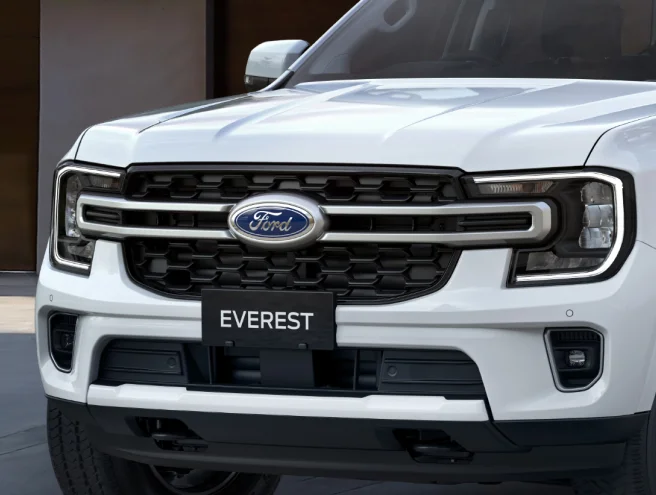
Image courtesy of ford.com.au
Performance from the base engine is great, though buyers looking for maximum power for towing or off-road adventures will not be disappointed while upgrading to the 3.0-litre V6.
Around town, the Everest is surprisingly user-friendly thanks to its well-weighted steering rack that is easy to throw around when parking, while offering a healthy amount of feedback as you pick up the pace.
While it’s based on the Ranger ute, the Everest picks up more refined multi-link coil suspension hardware at the rear, which means it doesn’t feel as jittery on a series of bumps.
This makes it a well-accomplished tourer that soaks up punishment on rougher country B-roads and settles into long-distance hauls up the highway with confidence-inspiring stability mixed with surefootedness, particularly in 4x4 variants.
All up, Ford has produced a great all-rounder that feels near bullet-proof on the road while remaining user-friendly on a daily drive around town.
Is the Ford Everest a Good Off-Roader?
The Ford Everest is a super versatile package that offers both family-friendly manners around town and great off-road abilities.
With 500Nm of torque in the base model increasing up to 600Nm in models with the 3.0-litre V6, the Everest has more than enough power on tap to conquer tough terrain.
Combine that with the Everest’s high-riding platform with great ground clearance, a clever 4x4 system with adjustable driving modes, a locking rear differential as standard and a super-capable suspension package and it’s super confident when the going gets tough.
While all members of the Everest lineup are impressive off-roaders, if you’re looking for the most capable member of the range, pay close attention to the Everest Tremor which receives a number of important hardware additions.
MY25.25 Ford Everest Tremor Off-Road Specs
-
Ground Clearance: 255mm
-
Wading Depth: 800mm
-
Approach Angle: 32.0 degrees
-
Departure Angle: 26.8 degrees
-
Breakover Angle: 23.9 degrees
Is the Ford Everest Fuel Efficient?
The Ford Everest range is reasonably fuel-efficient for a vehicle of its size and power outputs, with Ford’s entry-level 2.0-litre bi-turbo unit proving a particularly efficient unit.
On a combined cycle, the Ford Everest with the 2.0-litre bi-turbo four-cylinder is rated at 7.1L/100km in 4x2 form, increasing slightly to 7.2L/100km with the full-time 4x4 system.
All things considered, that’s some super impressive fuel efficiency for a large 4x4 SUV.
The pursuit of extra power with Ford’s 3.0-litre V6 diesel unit raises fuel economy figures to 8.5L/100km on a combined cycle.
Is the Ford Everest Practical and Spacious?
The Ford Everest is quick to assert itself as a family-favourite option in the segment with its handsome cabin and acres of interior space.
Family buyers should take note that the entry-level Everest Ambiente is offered as a five-seater as standard, with seven seats remaining optional, while the Trend and above pick up a three-row, seven-seater format.
Step inside and you’ll be pleased that even base models look pretty schmick, while more premium variants pick up leather upholstery and larger displays that make it feel more sophisticated and modern.
Climbing aboard is made simple via the side steps, with a fully-adjustable driving position making the Everest accommodating to a range of driver shapes and sizes.
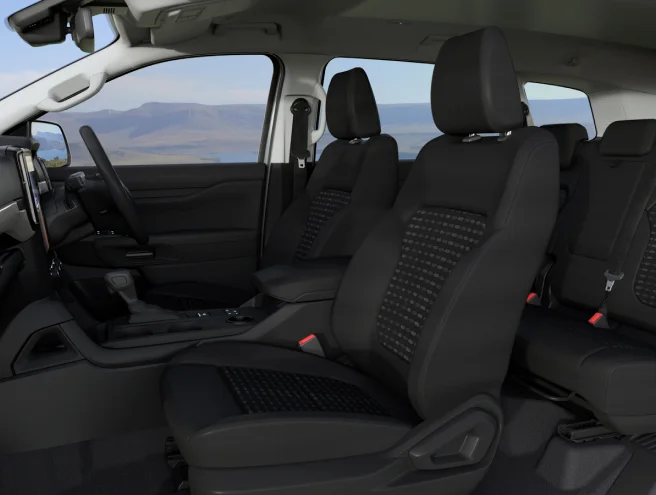
Image courtesy of ford.com.au
The amount of headroom up front is excellent, as is the forward and side visibility thanks to the tall roofline.
There’s a healthy amount of storage options in the front of the cabin, with the bulky centre console offering a storage stash and wireless charging pad behind the gear lever, a pair of cupholders and a sizable storage area underneath the folding armrest.
You’ll also find two gloveboxes, some pop-out cupholders on the dashboard and some bottle holders inside the door sills.
Move to the Everest’s second row and things are nice and spacious for anyone seated in the back, with no issues accommodating adults.
The Everest’s second-row seats are able to both slide and recline back and forth to help give more space to those in the third row or get extra comfortable on a long-distance haul up the highway.
For the parents out there, the Ford Everest range picks up two pairs of ISOFIX anchors and three top tether mounts behind the seatbacks for forward- and rear-facing child seats.
Move to the third row and things are pretty cramped, though the Everest’s rearmost gets the job done for younger kids, sitting pretty much on par for the large body-on-frame SUV segment with a spacious second row but ultimately a somewhat compromised third row.
All up, though, the Everest’s interior presentation and practical layout make it a heavy-hitter for large families.
How Big is the Ford Everest’s Boot?
The Ford Everest range offers a healthy amount of boot stuff to keep you and your family on the move.
With all three rows of seats standing in a seven-seat layout, the Everest’s boot measures 259L, which is quite the feat of interior packaging.
Fold the third row down in a more conventional five-seat arrangement and you’ve got 898L of cargo space at your disposal.
For maximum cargo space, folding both rows of seats down unlocks 1,823L worth of real estate in the back when it’s time to lug around camping gear or sports equipment.
-
Everest Boot Space Seven Seat: 259L
-
Everest Boot Space Five Seat: 898L
-
Everest Boot Space Max: 1,823L
Is the Ford Everest Safe?
Ford has thrown a tonne of safety equipment in with all members of the Everest range.
To make things even better for price-conscious buyers, the company doesn’t reserve many features for high-ranking members of the lineup.
This means that entry-level Everest variants pick up forward and reverse autonomous emergency braking, blind-spot monitoring, post-collision braking, lane-keep assist with departure warnings, a rear-view camera with front & rear parking sensors and nine airbags.
A surround-view monitor is, however, reserved for the range-topping Everest Platinum or comes as part of Ford’s optional Touring package.
Does the Ford Everest Have an ANCAP Safety Rating?
The Ford Everest range wears a five-star ANCAP safety rating after testing in 2022 saw it score the following marks.
-
Adult Occupant Protection: 86%
-
Child Occupant Protection: 93%
-
Vulnerable Road User Protection: 74%
-
Safety Assist: 86%
What Warranty Does the Ford Everest Come With?
Ford offers the MY25.25 Everest range with a five-year/unlimited-kilometre factory warranty.
Three years of servicing is priced at around $1,137 while five years of servicing costs around $1,906.
The company also offers a pre-paid service package for four years that totals $1,385.
Service intervals for the Ford Everest range stand at 12-months or 15,000-kilometres, whichever elapses first.
Our Verdict: Is the Ford Everest Worth it?
No matter how close you point the microscope, the Ford Everest is an incredibly strong package for the large, seven-seat 4x4 SUV segment.
While its bones are taken from the work-ready Ranger, the Everest is softer around the edges which makes it a more appealing daily driver without losing anything in the way of its adventurous spirit.
Combine that with lengthy equipment lists and a modern suite of technologies inside and the Ford Everest remains one of the most compelling options in the large SUV segment and is a great option for Australian families or those looking for a spacious towing partner.
If you’re in the market for a new car, be sure to reach out to one of our car-buying specialists who can help find you the best possible price.
Five Ford Everest Specs You Need to Know
-
Five-year/unlimited-kilometre warranty
-
2.0-litre bi-turbo & 3.0-litre V6 diesel engines available
-
3,500kg braked towing capacity
-
7.1 - 8.5L per 100km fuel economy figures (combined cycle)
-
Five-star ANCAP safety rating
Get in touch with one of our Car Buying Specialists today.
Request a quote